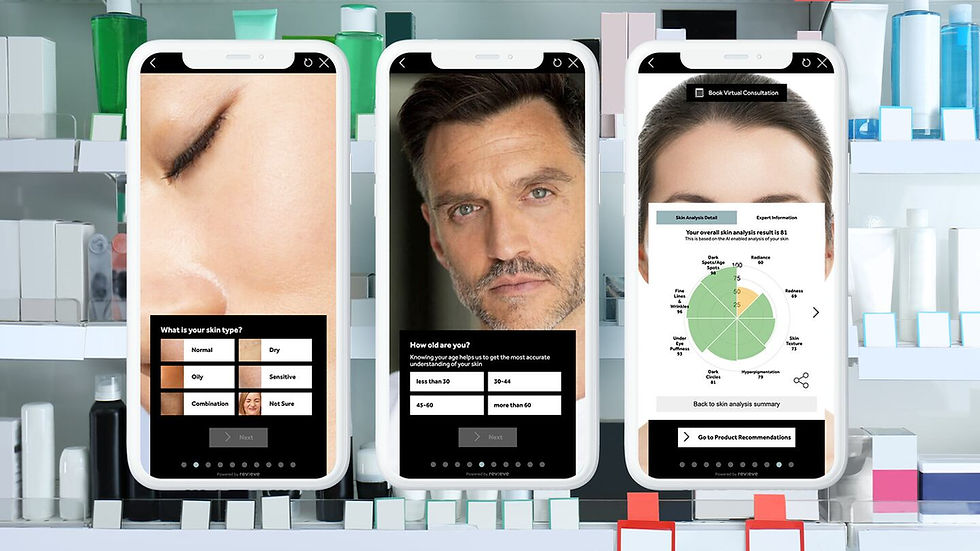How Beauty Brands Are Using Big Data to Develop Products
- Elena Strauss

- Mar 2
- 4 min read
By Elena Strauss, Product Innovation | International Institute of Beauty
In an age where information is the most valuable currency, the beauty industry is harnessing the power of big data to shape the future of skincare, haircare, and cosmetics. Gone are the days when product development relied solely on trend forecasting and consumer intuition.
Today’s most innovative beauty brands are using data driven insights to decode consumer needs, personalise offerings, and disrupt traditional product development cycles.

But how exactly is big data being used in beauty, and is it living up to the hype?
The Big Picture: What Is Big Data in Beauty?
At its core, big data refers to large, complex datasets that can be analysed to reveal patterns, trends, and associations, especially relating to human behaviour.
In the beauty industry, these datasets can include everything from social media activity and product reviews to skin diagnostic results and even weather data.
Brands are leveraging data from multiple sources:
Consumer purchase histories
Social media and influencer analytics
Dermatological databases
Online skin quizzes and app usage
Wearable and device collected biometrics
This amalgamation of structured and unstructured data allows companies to gain a more nuanced, real time understanding of consumer preferences, concerns, and expectations.
Personalisation: Data’s Most Beautiful Promise
One of the most visible outcomes of big data in beauty is personalised skincare. Brands like Proven, Function of Beauty, and Neutrogena are leading the way with algorithms that recommend or formulate products based on an individual’s unique profile.
Take Proven, for example. The brand analyses over 20,000 ingredients, 100,000 products, and eight million customer testimonials to deliver customised skincare regimens. This level of personalisation would have been unthinkable a decade ago, but is now made possible thanks to machine learning and powerful computing.
Even legacy brands are getting involved. L'Oréal’s acquisition of AI powered Modiface and Estée Lauder’s investment in voice and data analytics tools point to a broader shift: personalisation is no longer a trend, it's the new standard.
Predicting Trends Before They Happen
Thanks to social listening tools and trend forecasting algorithms, brands are now able to detect emerging beauty trends long before they reach mainstream popularity.
Big data helps analyse millions of posts, hashtags, and sentiment shifts to identify what’s catching consumer attention, sometimes even at the microtrend level.
For instance, the sudden boom in skin barrier repair products in 2023 was predicted months in advance by analytics teams scanning dermatology forums, Reddit threads, and TikTok skincare influencers.
This gave forward thinking brands a competitive edge in formulating and launching relevant products just as demand spiked.
Formulating Smarter, Not Just Faster
Big data doesn’t just influence marketing or customisation, it plays a pivotal role in R&D itself. Ingredient efficacy, safety profiles, skin type compatibility, and even potential allergen responses can all be optimised using advanced data modelling.
Start ups like Atolla and Revieve are using skin data from thousands of individuals to improve formulations based on real world results.
Meanwhile, AI led platforms can simulate the interaction of ingredients on various skin types, drastically reducing the trial and error process typically seen in labs.
This creates more efficient, effective formulations, and accelerates the journey from concept to consumer.
Sustainability Through Data
Beyond personalisation and performance, big data is driving sustainability in product innovation. By analysing supply chain data, consumer usage patterns, and environmental impact assessments, brands are making smarter decisions about packaging, ingredients, and sourcing.
For example, Lush uses data modelling to track ethical ingredient sourcing, while L'Oréal launched its environmental labelling system based on lifecycle analysis data.
By predicting demand more accurately, brands can also reduce waste and overproduction, issues that have long plagued the beauty sector.
Ethical Considerations: Data, Privacy, and Transparency
While the use of big data is reshaping the beauty landscape, it raises inevitable ethical questions, particularly around privacy and consent.
Consumers are increasingly concerned about how their data is collected, stored, and used. In response, transparent data policies, opt in features, and anonymisation of personal information are becoming non negotiable in the trust equation.
As data becomes more integral to product development, brands must ensure that innovation doesn’t come at the cost of ethics.
What the Future Holds
Looking ahead, the intersection of big data, AI, and biotechnology is poised to transform beauty even further. Imagine skincare powered by your microbiome profile, or foundations that auto adjust tone and texture via wearable sensors. These ideas may sound sci fi today, but data is paving the way.
We’re entering an era where product innovation is not just fast and reactive, it’s predictive, hyper personal, and deeply consumer centric. And while challenges remain, the brands that use data responsibly and creatively will be the ones to lead the next evolution of beauty.
Final Word from the Institute
Big data isn’t just changing the way we think about beauty, it’s changing the way we design it. From precision formulations to predictive trend analysis, the future of beauty lies in numbers.
But in a world of algorithms and analytics, the brands that balance data with empathy, transparency, and creativity will ultimately rise above the noise.



Comments